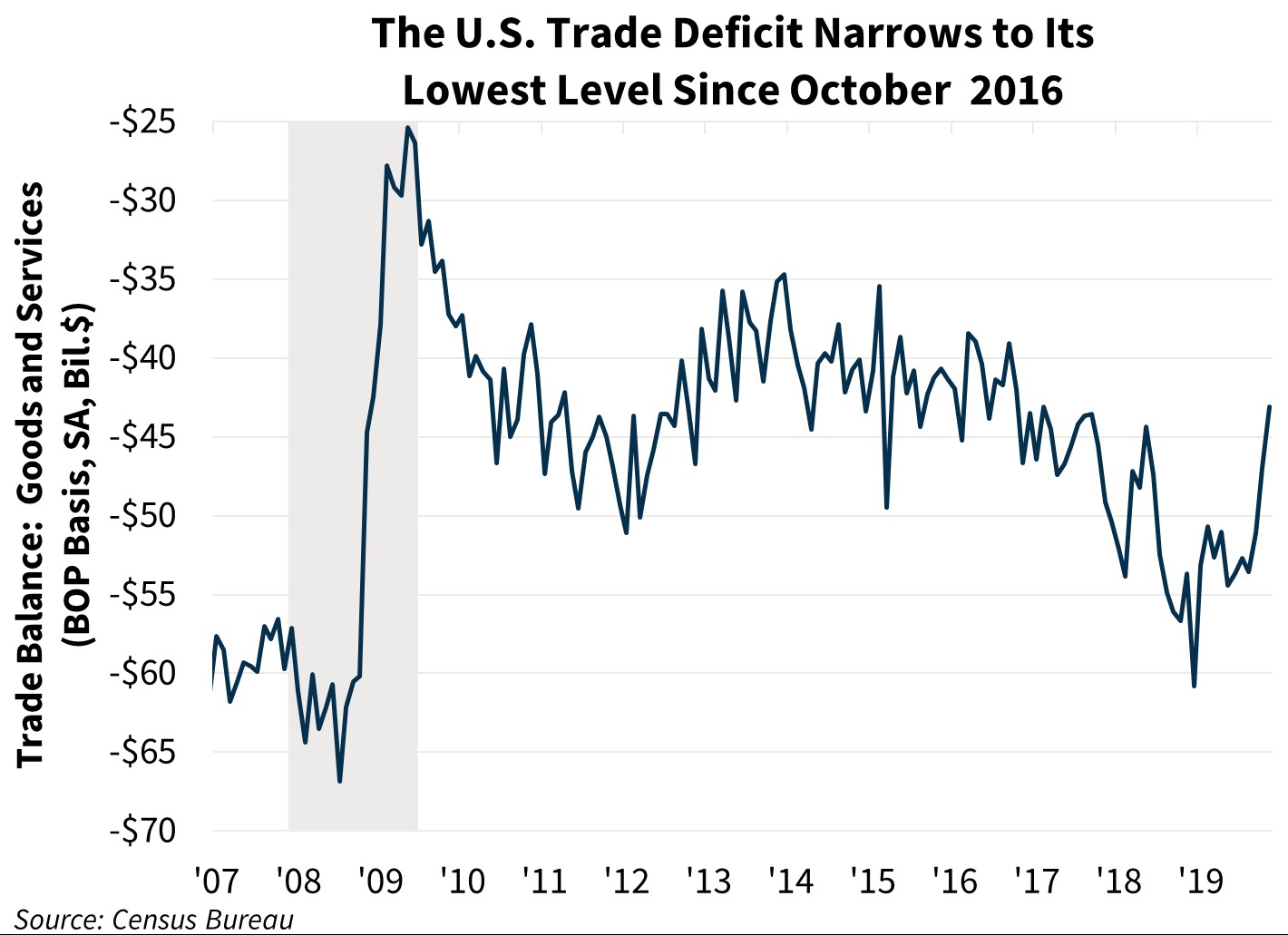Employment Report Not Expected to Change Fed's "Wait and See" Approach
Key Takeaways:
- Job growth was solid in December although it slowed from the strong pace seen in November. The unemployment rate and average workweek remained stable, and growth in average hourly earnings remained solid – although it decelerated to the slowest year-over-year pace in 17 months.
- The nominal U.S. trade deficit narrowed sharply in November to the lowest level since October 2016.
- Factory orders fell 0.7 percent in November as shipments rose 0.3 percent. Core orders rose 0.2 percent, while core shipments dropped 0.3 percent.
- The ISM Nonmanufacturing Index ended the year at 55.0, rising to its highest level since August and remaining comfortably in expansionary territory.
Forecast Impact
Given the solid-enough December jobs report and the continued expansion of the service sector, according to the ISM Nonmanufacturing Index, we believe the Fed will be content to continue their current "wait-and-see" stance. The labor market continues to support the household sector, and both are likely to continue driving the economy at or close to trend. The sharp narrowing of the trade deficit in November indicates that net exports will likely add to growth in the fourth quarter, although weakness in November factory orders and core shipments suggest weaker business equipment investment.


Details on Key Takeaways and Other Releases
- Nonfarm payroll employment rose by 145,000 in December, according to the Bureau of Labor Statistics. The three-month moving average fell to 184,000. Job gains for both October and November were revised downward by a total of 14,000, ending a three-month streak of upward revisions to prior months. The average workweek was unchanged at 34.3 hours for the third month in a row, while average hourly earnings increased 0.1 percent over the month and 2.9 percent from a year ago, the slowest annual pace of growth since July 2018. The unemployment rate remained unchanged at 3.5 percent as the labor force rose by 209,000. The prime-age (25-to 54-years old) labor force participation rate rose to 82.9 percent, tying the highest level of the expansion. Manufacturing employment fell by 12,000, adding only 46,000 jobs in 2019. Residential construction employment (which includes specialty contractors) added 3,200 jobs, adding a total of 76,600 in 2019.
- The U.S. trade deficit narrowed by $3.9 billion in November to $43.1 billion, according to the Census Bureau. Exports rose 0.7 percent, while imports fell 1.0 percent. The real goods trade deficit, which is used as an input to estimate the net exports component of GDP, narrowed by $3.7 billion to $75.3 billion.
- Factory orders fell 0.7 percent in November, according to the Census Bureau. Shipments rose 0.3 percent. Orders and shipments of nondurable goods both increased 0.6 percent. Core orders (nondefense excluding aircraft) rose 0.2 percent, an upward revision of 0.1 percent from the advance report, while core shipments dropped 0.3 percent.
- The ISM Nonmanufacturing Index, a gauge of service sector activity, rose 1.1 points to 55.0 in December. (Any reading above 50 indicates expansion.) The new orders and employment indices both fell, though the business activity index rose by 5.6 to 57.2, the highest since August. The import index rose 3 points to 48.0, the fourth straight month of contraction.
Ricky Goyette
Economic and Strategic Research Group
January 10, 2020
Opinions, analyses, estimates, forecasts and other views of Fannie Mae's Economic and Strategic Research (ESR) Group included in these materials should not be construed as indicating Fannie Mae's business prospects or expected results, are based on a number of assumptions, and are subject to change without notice. How this information affects Fannie Mae will depend on many factors. Although the ESR group bases its opinions, analyses, estimates, forecasts and other views on information it considers reliable, it does not guarantee that the information provided in these materials is accurate, current or suitable for any particular purpose. Changes in the assumptions or the information underlying these views could produce materially different results. The analyses, opinions, estimates, forecasts and other views published by the ESR group represent the views of that group as of the date indicated and do not necessarily represent the views of Fannie Mae or its management.
